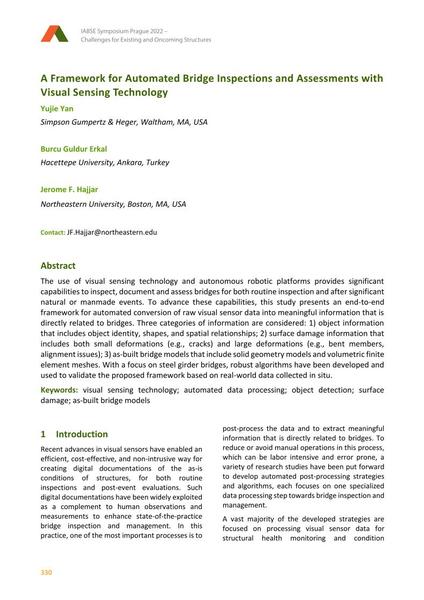A Framework for Automated Bridge Inspections and Assessments with Visual Sensing Technology

|
|
|||||||||||
Détails bibliographiques
| Auteur(s): |
Yujie Yan
(Simpson Gumpertz & Heger, Waltham, MA, USA)
Burcu Guldur Erkal (Hacettepe University, Ankara, Turkey) Jerome F. Hajjar (Northeastern University, Boston, MA, USA) |
||||
|---|---|---|---|---|---|
| Médium: | papier de conférence | ||||
| Langue(s): | anglais | ||||
| Conférence: | IABSE Symposium: Challenges for Existing and Oncoming Structures, Prague, Czech Republic, 25-27 May 2022 | ||||
| Publié dans: | IABSE Symposium Prague 2022 | ||||
|
|||||
| Page(s): | 330-337 | ||||
| Nombre total de pages (du PDF): | 8 | ||||
| DOI: | 10.2749/prague.2022.0330 | ||||
| Abstrait: |
The use of visual sensing technology and autonomous robotic platforms provides significant capabilities to inspect, document and assess bridges for both routine inspection and after significant natural or manmade events. To advance these capabilities, this study presents an end-to-end framework for automated conversion of raw visual sensor data into meaningful information that is directly related to bridges. Three categories of information are considered: 1) object information that includes object identity, shapes, and spatial relationships; 2) surface damage information that includes both small deformations (e.g., cracks) and large deformations (e.g., bent members, alignment issues); 3) as-built bridge models that include solid geometry models and volumetric finite element meshes. With a focus on steel girder bridges, robust algorithms have been developed and used to validate the proposed framework based on real-world data collected in situ. |
||||
| Copyright: | © 2022 International Association for Bridge and Structural Engineering (IABSE) | ||||
| License: | Cette oeuvre ne peut être utilisée sans la permission de l'auteur ou détenteur des droits. |
||||
